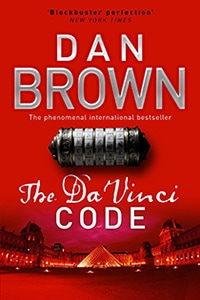“Blockbuster perfection… An exhilaratingly brainy thriller. Not since the advent of Harry Potter has an author so flagrantly delighted in leading readers on a breathless chase.”
NO MAJOR SPOILERS
A must-read for anyone studying Renaissance art, Dan Brown’s The Da Vinci Code has regularly hit the ceiling in the bestselling title list. Filled with historical facts that are not only intriguing but also informative at the very least, The Da Vinci Code is a rapid page turner and one of the best books of the century.

Set in Paris, the book catches the reader’s attention from the very beginning. The story starts with a murder, the murder of the curator of Louvre Museum, Jacques Saunière. The story continues to introduce the main character, Robert Langdon, a professor of Symbology at Harvard. His eidetic memory and vast knowledge of art history and symbology makes him the perfect fit for the novel. Woken up at midnight, Langdon is called by the police who suspect that he might have blood on his hands, but never let Langdon realize their suspicion. But Langdon is saved from jail and questioning by Sophie Neveu, an agent of the Cryptography unit of the DCPG who turns out to be the daughter of Saunière. They rapidly decipher the code written by Saunière on the floor and proceed according to the instructions. Now on the run, Langdon becomes the prime suspect of the murder for the police. Meanwhile, a Catholic sect named the Opus Dei seems to be trying to do whatever possible to decipher the greatest secret of all time, the quest for finding the Holy Grail, or the San Greal, before Langdon does the same. Saunière’s code leads to a series of codes that must be solved before the ultimate secret is revealed. Proceeding in the story, it turns out that Jacques Saunière was the Grand Master of the Priory of Sion, a society whose main aim is to protect the secrets of the Holy Grail.
Sophie and Langdon quickly decipher a series of clues laid down by Saunière, and are plunged into Renaissance art, biblical allusions and symbological clues. The author calls to attention the two main art pieces depicted in the novel, Monalisa and The Last Supper, both by Leonardo Da Vinci, one of the greatest artisans of all time, who turns out to be the greatest Grand Master of the Priory of Sion of his time.
The novel continues to tell a tale of mystery, deceptions, startling twists, and enthralling truths. The main part of the story talks about the Holy Grail and Jesus’ supposed wife, Mary Magdalene. As Langdon and Sophie solve riddles one after another, they move towards Leonardo Da Vinci and his famous artwork, The Last Supper. The secrets hidden in the painting in plain sight increases the pace of the story and the duo get involved in the quest for the Holy Grail. The Grail, being interlinked with thousands of mysteries, including the secret of the Knights Templar and above all, the mortal life of Jesus Christ, acts as a perfect plot for the novel. The story continues to tell how Sophie and Langdon decipher the secrets of Da Vinci and The Priory of Sion, with the help of a former British Royal Historian, Leigh Teabing, one of Langdon’s trusted friends.
The story ends with a deception, a deception that shakes the plot of the story, and again proves Brown’s fame as a world-renowned author.
The rapid rise of The Da Vinci Code to the top of the bestselling list could be credited to the successful portrayal of historical facts in an interesting and intriguing way that enraptures the mind of the reader.
The latest version of the book is the special illustrated collector’s edition, published by Bantam Press, London. Book design and layout has been done by Judith Stagnitto Abbate from Abbate Design. The original hardcover edition of The Da Vinci Code was published in 2003 while this new illustrated edition came out in 2004. The several images in the book range from Renaissance art to architectural pictures, thus adding pace to the story and increasing the easy accessibility of the images of the historical architecture and paintings portrayed in the book.
Reviewed by:
Soham Saha (Age 13)
Added 18th December 2020

